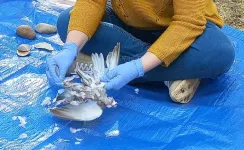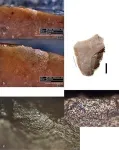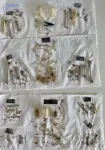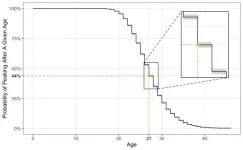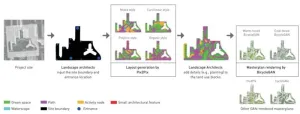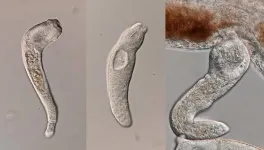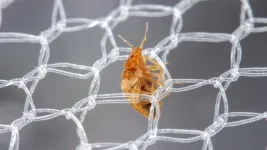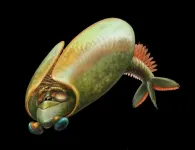(Press-News.org) It's hard to know what Neanderthals ate: food preparation, especially when it comes to smaller items like birds, can leave few archaeological traces. But understanding their diets is critical to understanding these incredibly adaptable hominins, who thrived for hundreds of thousands of years in wildly varied environments. To learn what food preparation could look like in the archaeological record, scientists tried cooking like Neanderthals.
“Using a flint flake for butchering required significant precision and effort, which we had not fully valued before this experiment,” said Dr Mariana Nabais of the Institut Català de Paleoecologia Humana i Evolució Social in Spain, lead author of the article in Frontiers in Environmental Archaeology. “The flakes were sharper than we initially thought, requiring careful handling to make precise cuts without injuring our own fingers. These hands-on experiments emphasized the practical challenges involved in Neanderthal food processing and cooking, providing a tangible connection to their daily life and survival strategies.”
You are what you eat
Although the big game hunting practiced by Neanderthals is well known, we know less about the birds that some Neanderthals hunted. But recent discoveries and new techniques allow us to investigate this more deeply. By testing food preparation methods that Neanderthals could have used, to see what traces these might leave on bones and how those traces compare to damage caused by natural processes or the actions of other animals, the scientists created an experimental database that can be compared to real archaeological sites.
The scientists collected five wild birds that had died of natural causes from the Wildlife Ecology, Rehabilitation and Surveillance Centre (CERVAS) in Gouveia, Portugal. They chose two carrion crows, two collared doves, and a wood pigeon, which are similar to species that Neanderthals ate, and selected cooking methods using archaeological evidence and ethnographic data.
All the birds were defeathered by hand. A carrion crow and a collared dove were then butchered raw, using a flint flake. The remaining three were roasted over hot coals until cooked, then butchered, which the scientists found much easier than butchering the raw birds.
“Roasting the birds over the coals required maintaining a consistent temperature and carefully monitoring the cooking duration to avoid overcooking the meat,” said Nabais. “Maybe because we defeathered the birds before cooking, the roasting process was much quicker than we anticipated. In fact, we spent more time preparing the coals than on the actual cooking, which took less than ten minutes.”
Putting flesh on prehistoric bones
The scientists cleaned and dried the bones, then examined them microscopically for cutmarks, breaks, and burns. They also examined the flint flake they had used for evidence of wear and tear. Although they had used their hands for most of the butchery, the raw birds required considerable use of the flint flake, which now had small half-moon scars on the edge. While the cuts used to remove meat from the raw birds did not leave traces on the bones, the cuts aimed at tendons left marks similar to those on birds found at archaeological sites.
The bones from the roasted birds were more brittle: some had shattered and couldn’t be recovered. Nearly all of them had brown or black burns consistent with controlled exposure to heat. Black stains inside some bones suggested that the contents of the inner cavity had also burned. This evidence sheds light not just on how Neanderthal food preparation could have worked, but also how visible that preparation might be in the archaeological record. Although roasting makes it easier to access meat, the increased fragility of the bones means the leftovers might not be found by archaeologists.
However, the scientists cautioned that this research should be expanded to gain a fuller understanding of Neanderthal diets. Future studies should include more species of small prey, as well as processing birds for non-food products, like talons or feathers.
“The sample size is relatively small, consisting of only five bird specimens, which may not fully represent the diversity of bird species that Neanderthals might have used,” noted Nabais. “Secondly, the experimental conditions, although carefully controlled, cannot completely replicate the exact environmental and cultural contexts of Neanderthal life. Further research with larger samples, varied species, and more diverse experimental conditions is necessary to expand upon these results.”
END
Cook like a Neanderthal: Scientists try to replicate ancient butchering methods to learn how Neanderthals ate birds
A pilot study indicates that fire-roasted birds are easier to process, but only birds butchered raw show cutmarks — evidence that we can use to understand Neanderthal diets
2024-07-24
ELSE PRESS RELEASES FROM THIS DATE:
New study finds alarming rise in persistent ‘forever chemicals’ in pesticides
2024-07-24
WASHINGTON — A peer-reviewed study published today in the journal Environmental Health Perspectives has found that per- and polyfluoroalkyl substances (PFAS), known as “forever chemicals,” are increasingly being added to U.S. pesticide products, contaminating waterways and posing potential threats to human health.
The study, Forever Pesticides: A Growing Source of PFAS Contamination in the Environment, is the first-ever comprehensive review of the many ways PFAS are introduced into U.S. pesticide products. Pesticides containing PFAS are used throughout the country on staple ...
At what age do Olympic athletes peak?
2024-07-24
There’s a lot that goes into an Olympic athlete’s quest for gold – years of training and rigour – but also, an athlete’s age. A team of University of Waterloo students used statistics to figure out when an Olympic track-and-field athletes’ peak performance will be.
Track-and-field encompasses running, jumping, throwing, and combined event disciplines. Most athletes’ career performance progressions can typically be visualized as a bell curve, in which they train over several years to reach their best performance, or “peak,” at a ...
Link found between kneecap shape and debilitating joint disease
2024-07-24
The shape of a person’s kneecap could be an indicator of whether they’re more at risk of developing osteoarthritis, according to a new study from The Australian National University (ANU).
According to lead author of the study, Associate Professor Laura Wilson, women who develop knee osteoarthritis often experience more severe symptoms than men, but the reason for this is not well understood. Osteoarthritis, the most common form of arthritis, is a debilitating joint disease that causes pain, stiffness and swelling.
The research team set out to investigate whether kneecap shape might be a contributing factor.
“We wanted to focus on ...
Generative AI tools like Pix2Pix–BicycleGAN are revolutionizing landscape design by enhancing masterplan generation and rendering
2024-07-24
In recent years, the rapid development and enhancement of image generation technologies and mapping tools driven by generative artificial intelligence (AI) have significantly impacted the traditional landscape design industry. Thus, it is pressing for landscape architects to delineate the relationship between image generation and landscape design and explore potential opportunities of practice and research. Research on masterplan generation primarily focuses on “image-to-image” generative adversarial network (GAN). The application of these tools has developed from the generation of architectural floor ...
Expanding APAC presence, Insilico Medicine seals strategic collaboration on AI-driven mash therapy development with Korean Biotech Therasid Bioscience
2024-07-24
Insilico Medicine(“Insilico”), a clinical-stage generative artificial intelligence (AI)-driven drug discovery company, recently announces that the company has entered a strategic collaboration with Therasid Bioscience, an innovative biotechnology company founded in South Korea, to utilize advanced AI technology to co-develop novel therapies for the treatment of metabolic dysfunction associated steatohepatitis (MASH).
MASH, previously known as Non-alcoholic steatohepatitis (NASH), is a severe form of non-alcoholic fatty liver disease (NAFLD), characterized by liver inflammation and damage caused by a buildup of fat. Potentially progressing ...
When it comes to butterflies, people prefer pretty ones. That’s a problem for scientists.
2024-07-24
Research shows humans often perceive attractive people as more intelligent, healthier, better leaders and more trustworthy. It turns out this bias extends to the insect world.
A new study by scientists at the USC Dornsife College of Letters, Arts and Sciences reveals that data reported on a popular community science platform is biased. On iNaturalist, butterflies with captivating markings, easily identifiable features or those that are familiar species are reported more frequently than obscure species with no distinct qualities.
Why it matters: Online ...
UBC Okanagan study raises concerns about partner violence in queer relationships
2024-07-24
When people think of a concussion or a traumatic brain injury caused by intimate partner violence (IPV), they might picture people in a heterosexual relationship, or a man hurting a woman.
But a UBC Okanagan researcher points out that IPV, and its repercussions, is an issue in all relationships. Doctoral student Tori Stranges recently published a paper examining the prevalence and damage done by violence in Two-Spirit, Lesbian, Gay, Bisexual, Trans, Queer (or Questioning), Intersex and Asexual (2SLGBTQIA+) relationships.
“It’s very common for people to think that violence doesn’t ...
Human-infecting parasite produces sterile soldiers like ants and termites
2024-07-24
New research from scientists at UC San Diego’s Scripps Institution of Oceanography finds a tiny freshwater parasite known to cause health problems in humans defends its colonies with a class of soldiers that cannot reproduce.
The discovery, published today in the Proceedings of the National Academy of Sciences and funded by the National Institutes of Health, vaults this species of parasitic flatworm into the ranks of complex animal societies such as ants, bees and termites, which also have distinct classes of workers and soldiers that have given up reproduction to serve their colony.
When it gets into humans, usually via the consumption of raw or undercooked fish, this species ...
The unintended consequences of success against malaria
2024-07-24
For decades, insecticide-treated bed nets and indoor insecticide spraying regimens have been important – and widely successful – treatments against mosquitoes that transmit malaria, a dangerous global disease. Yet these treatments also – for a time – suppressed undesirable household insects like bed bugs, cockroaches and flies.
Now, a new North Carolina State University study reviewing the academic literature on indoor pest control shows that as the household insects developed resistance ...
Taco-shaped arthropod from Royal Ontario Museum’s Burgess Shale fossils gives new insights into the history of the first mandibulates
2024-07-24
A new study, led by palaeontologists at the Royal Ontario Museum (ROM) is helping resolve the evolution and ecology of Odaraia, a taco-shaped marine animal that lived during the Cambrian period. Fossils collected by ROM reveal Odaraia had mandibles. Palaeontologists are finally able to place it as belonging to the mandibulates, ending its long enigmatic classification among the arthropods since it was first discovered in the Burgess Shale over 100 years ago and revealing more about early evolution and diversification. The study The Cambrian Odaraia alata and the colonization of nektonic suspension-feeding niches by early mandibulates was published ...
LAST 30 PRESS RELEASES:
Electrodes created using light
Second-hand gift-giving is a well-deliberated decision
How human interaction drove evolution to make bears less aggressive
National Poll: Few parents offer teens guidance on healthy eating during holiday season
Cannabis derivatives could provide new ovarian cancer treatments
Raising strong yeast as a petroleum substitute
Clues to the origin of hot Jupiters hidden in their orbits
Canada’s reduced pledge to Global Fund will impact domestic health
1 in 4 children with major traumatic injuries not cared for in pediatric trauma centres
Duke and Duke-NUS’ joint cross-population research to uncover "East-West" differences in disease and care
Scientists to ‘spy’ on cancer- immune cell interactions using quantum technology breakthrough
Tech savvy users have most digital concerns
Making lighter work of calculating fluid and heat flow
Normalizing blood sugar can halve heart attack risk
Lowering blood sugar cuts heart attack risk in people with prediabetes
Study links genetic variants to risk of blinding eye disease in premature infants
Non-opioid ‘pain sponge’ therapy halts cartilage degeneration and relieves chronic pain
AI can pick up cultural values by mimicking how kids learn
China’s ecological redlines offer fast track to 30 x 30 global conservation goal
Invisible indoor threats: emerging household contaminants and their growing risks to human health
Adding antibody treatment to chemo boosts outcomes for children with rare cancer
Germline pathogenic variants among women without a history of breast cancer
Tanning beds triple melanoma risk, potentially causing broad DNA damage
Unique bond identified as key to viral infection speed
Indoor tanning makes youthful skin much older on a genetic level
Mouse model sheds new light on the causes and potential solutions to human GI problems linked to muscular dystrophy
The Journal of Nuclear Medicine ahead-of-print tip sheet: December 12, 2025
Smarter tools for peering into the microscopic world
Applications open for funding to conduct research in the Kinsey Institute archives
Global measure underestimates the severity of food insecurity
[Press-News.org] Cook like a Neanderthal: Scientists try to replicate ancient butchering methods to learn how Neanderthals ate birdsA pilot study indicates that fire-roasted birds are easier to process, but only birds butchered raw show cutmarks — evidence that we can use to understand Neanderthal diets
